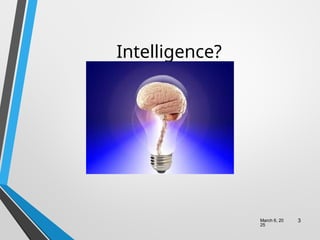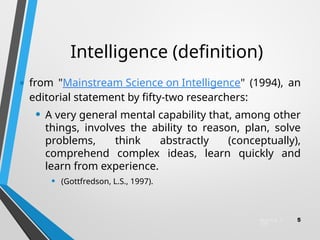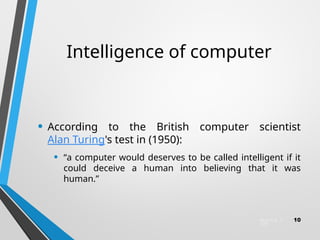MLecture 1 Introduction to AI . The basics.pptx
- 2. Agenda • Intelligence • Intelligence of computer • Artificial intelligence • Intelligent computing Vs Conventional computing • Contribution of other fields to AI • +History of AI • +Applications of AI • References • End March 6, 2 025 2
- 4. Can Intelligence be defined? • Intelligence can not be defined abstractly/ precisely. • There are probably as many definitions of intelligence as there are experts of this field. March 6, 2 025 4
- 5. Intelligence (definition) • from "Mainstream Science on Intelligence" (1994), an editorial statement by fifty-two researchers: • A very general mental capability that, among other things, involves the ability to reason, plan, solve problems, think abstractly (conceptually), comprehend complex ideas, learn quickly and learn from experience. • (Gottfredson, L.S., 1997). March 6, 2 025 5
- 7. Intelligence • from "Intelligence: Knowns and Unknowns" (1995), a report published by the Board of Scientific Affairs of the American Psychological Association: • Individuals differ from one another in their ability to understand complex ideas, to adapt effectively to the environment, to learn from experience, to engage in various forms of reasoning, to overcome obstacles by taking thought. • (Neisser, 1997) and (Perloff, 1996) March 6, 2 025 7
- 8. Other definitions of intelligence • capacity for learning, reasoning, understanding, and similar forms of mental activity; aptitude (ability) in grasping truths, relationships, facts, meanings, etc. • the faculty of understanding. • knowledge of an event, circumstance, etc., received or imparted; news; information. • the gathering or distribution of information, especially secret information • www. dictionary.com March 6, 2 025 8
- 9. Intelligence (summary) •Intelligence is the ability of: • abstract thought • understanding • communication • reasoning • learning • planning • problem solving March 6, 2 025 9
- 10. Intelligence of computer • According to the British computer scientist Alan Turing's test in (1950): • “a computer would deserves to be called intelligent if it could deceive a human into believing that it was human.” March 6, 2 025 10
- 11. Artificial Intelligence? • ??? March 6, 2 025 11
- 12. Artificial Intelligence • “A branch of a computer science which studies the development of software and hardware which simulates human intelligence” • (Dr. Ghassan Issa) March 6, 2 025 12
- 13. Artificial Intelligence • AI is the part of computer science concerned with designing intelligent computer systems, that is, computer systems that exhibit the characteristics we associate with intelligence in human behavior- • Understanding languages, • learning, • reasoning, • solving problems, and so on. • (Barr and Feigenbaum, 1981) March 6, 2 025 13
- 14. Other Definitions of AI …. • “AI is the study of how to make computer do things at which, at the moment, people are better” • (Rich and Knight, 1991) • “AI is study of idea that enable computers to be intelligent” • (Patrick H. Winston) March 6, 2 025 14
- 15. Intelligent computing Vs Conventional computing Intelligent Computing Conventional Computing 1 Does not always guarantee a solution to a given problem. 1 Always guarantees a solution to a given problem. 2 Results may not be reliable and consistent 2 Results are consistent and reliable. 3 Programmer does not tell the system how to solve the given problem. 3 Programmer tells the system exactly how to solve the problem 4 Can solve a range of problems in a given domain. 4 Can solve only one problem at a time in a given domain March 6, 2 025 15
- 16. Intelligent computing Vs Conventional computing … • Conventional: • Based on algorithms whose instructions are stored in memory and executed in sequential way. • AI Computing: • Not based on algorithms but based on: • Knowledge base (symbolic representation) • Uses reasoning and inferencing over the knowledge base to search and perform pattern matching. March 6, 2 025 16
- 17. Intelligent computing Vs Conventional computing … March 6, 2 025 17
- 18. Types of AI All artificial intelligence systems - real and hypothetical - fall into one of three types: • Artificial narrow intelligence (ANI), which has a narrow range of abilities; • Artificial general intelligence (AGI), which is on par with human capabilities; or • Artificial superintelligence (ASI), which is more capable than a human. March 6, 2 025 18 What are the 3 types of AI? A guide to narrow, general, and super artificial intelligence | Codebots
- 19. 1. Artificial Narrow Intelligence • Artificial narrow intelligence (ANI), also referred to as weak AI or narrow AI. • The only type of artificial intelligence we have successfully realized to date. • Narrow AI is goal-oriented, designed to perform singular tasks - i.e. facial recognition, speech recognition/voice assistants, driving a car, or searching the internet - and is very intelligent at completing the specific task it is programmed to do. March 6, 2 025 19
- 20. 2. Artificial General Intelligence • Artificial general intelligence (AGI), also referred to as strong AI or deep AI. • It is the concept of a machine with general intelligence that mimics human intelligence and/or behaviours, with the ability to learn and apply its intelligence to solve any problem. • AGI can think, understand, and act in a way that is indistinguishable from that of a human in any given situation. March 6, 2 025 20
- 21. 2. Artificial General Intelligence • Fujitsu-built K, one of the fastest supercomputers, is one of the most notable attempts at achieving strong AI, but considering it took 40 minutes to simulate a single second of neural activity , it is difficult to determine whether or not strong AI will be achieved in our foreseeable future. • K is upgraded now to Fugaku March 6, 2 025 21
- 22. 3. Artificial Superintelligence • Artificial super intelligence (ASI), is the hypothetical AI that doesn’t just mimic or understand human intelligence and behaviour; ASI is where machines become self-aware and surpass the capacity of human intelligence and ability. • Superintelligence has long been a fiction in which robots overrun, overthrow, and/or enslave humanity. • The concept of artificial superintelligence sees AI will evolve to human emotions and experiences, that it doesn’t just understand them, it evokes emotions, needs, beliefs and desires of its own. March 6, 2 025 22
- 23. Gary Kasparov, world chess champion in Munich, Germany(2020) • we have more to win than lose when it comes to AI, and that rather than becoming obsolete, humans are going to be promoted. • “Jobs don’t disappear, they evolve. Deleting people from repetitive jobs frees them up to be more creative. The future of the human race is there in creativity. • “The future is about humans and machines working together. AI will bring you what you want the most…time.” March 6, 2 025 23
- 24. Applications of AI • Game playing • General problem solving • Expert system • Natural language Processing • Computer vision • Robotics • Education • Others March 6, 2 025 24
- 25. Game Playing • Game Playing is an important domain of artificial intelligence. • Games don't require much knowledge; the only knowledge we need to provide is the rules, legal moves and the conditions of winning or losing the game. • Generate procedure so that only good moves are generated March 6, 2 025 25
- 26. General problem solving • In computer science, problem-solving refers to artificial intelligence techniques, including various techniques such as forming efficient algorithms, heuristics, and performing root cause analysis to find desirable solutions • A problem consists of five parts: The state space, an initial situation, actions, a goal test, and path costs. • Chess, Tower of Hanoi Problem, Travelling Salesman Problem, Water-Jug Problem etc. March 6, 2 025 26 Problem Solving Techniques in Artificial Intelligence (AI) | PDF.co
- 27. Expert Systems • In artificial intelligence, an expert system is a computer system emulating the decision-making ability of a human expert. • Expert systems are designed to solve complex problems by reasoning through bodies of knowledge, represented mainly as if–then rules rather than through conventional procedural code. Wikipedia March 6, 2 025 27
- 28. Natural language processing (NLP) • Natural language processing (NLP) is a subfield of linguistics, computer science, and artificial intelligence concerned with the interactions between computers and human language, in particular how to program computers to process and analyze large amounts of natural language data. March 6, 2 025 28
- 29. Computer Vision • Computer vision is defined as “a subset of mainstream artificial intelligence that deals with the science of making computers or machines visually enabled, i.e., they can analyze and understand an image. • Computer vision is an interdisciplinary scientific field that deals with how computers can gain high- level understanding from digital images or videos. March 6, 2 025 29
- 30. Robotics • Robotics is a domain in artificial intelligence that deals with the study of creating intelligent and efficient robots. • Robotics and artificial intelligence are really two separate things. Robotics involves building robots physical whereas AI involves programming intelligence. • Artificial Intelligence or AI gives robots a computer vision to navigate, sense and calculate their reaction accordingly. • Robots learn to perform their tasks from humans through machine learning which again is a part of computer programming and AI. March 6, 2 025 30
- 31. Education • Artificial intelligence can automate basic activities in education, like grading. • Educational software can be adapted to student needs. • It can point out places where courses need to improve • Students could get additional support from AI tutors. • AI-driven programs can give students and educators helpful feedback. • AI may change where students learn, who teaches them, and how they acquire basic skills. March 6, 2 025 31
- 32. Contributions of other disciplines to AI 1. Philosophy Logic, methods of reasoning, mind as physical system, foundations of learning, language, rationality (wisdom) 2. Mathematics Formal representation and proof of algorithms, computation, (un)decidability, (in)tractability, probability 3. Economics utility, decision theory 4. Neuroscience how do brain process information (neuron operation) 5. Psychology 1- How do humans and animals think and act 2- phenomena of perception and motor control, experimental techniques 6. Computer engineering building fast computers 7. Control theory 1- How can artifacts (objects) operate under their own control? 8. 2- design systems that maximize an objective function over time. 9. Linguistics knowledge representation, grammar March 6, 2 025 32
- 33. Abridged history of artificial intelligence • 1941 first electric computer was developed • 1943 McCulloch & Pitts: • Boolean circuit model of brain • 1949 first “stored program” computer was introduced • 1950 Turing proposed his “Turing Test” for intelligence. • 1955 early chess playing programs demonstrated • 1956 in Dartmouth conference birth was given to: • "Artificial Intelligence" • 1957 LISP language by John McCarthy at MIT March 6, 2 025 33
- 34. Abridged history of artificial intelligence • 1965 expert system DENDRAL started at Stanford • 1965 Robinson's complete algorithm for logical reasoning • 1966 expert system MACSYMA started at MIT • 1969—79 Early development of knowledge-based systems • 1970 implementation of the Prolog language • 1972 expert system MYCIN developed at Stanford • 1972 SHRDLU natural language robot demonstrated at MIT March 6, 2 025 34
- 35. Abridged history of artificial intelligence • 1980-- AI becomes an industry • 1981--Commercial NLP system “Intellect” available from NLP group • 1986-- Neural networks return to popularity • 1987--AI becomes a science • 1995--The emergence of intelligent agents • 1995-2007 HLAI (Human Level AI): • AI should return to its roots of striving "machines that think, that learn” • Hays and Efros (2007) • discuss the problem of filling in holes in a photograph March 6, 2 025 35
- 36. Abridged history of artificial intelligence • 2008--Artificial General Intelligence or AGI • AGI looks for a universal algorithm for learning and acting in any environment • 2009 :Google builds self driving car • 2011–2014 : Apple's Siri (2011), Google's Google Now (2012) and Microsoft's Cortana (2014) are smartphone apps that use natural language to answer questions, make recommendations and perform actions. • 2018: Alibaba language processing AI outscores top humans at a Stanford University reading and comprehension test, scoring 82.44 against 82.304 on a set of 100,000 questions. • 2020: Extensive use of AI in industry and businesses like JD, Alibaba, Amazon, Daraz etc March 6, 2 025 36
Editor's Notes
- #9: Abstract: Non concrete, intangible, nonfigurative, theoretical,
- #24: Chatbots: ..., Artificial Intelligence in eCommerce: ... AI to Improve Workplace Communication: ..., Human Resource Management: ..., AI in Healthcare: ..., Intelligent Cybersecurity: ..., Artificial Intelligence in Logistics and Supply Chain: ..., Sports betting Industry
- #26: The heuristic method helps comprehend a problem and devises a solution based purely on experiments and trial and error methods. However, these heuristics do not often provide the best optimal solution to a specific problem. Instead, these undoubtedly offer efficient solutions to attain immediate goals. Chess, N-Queen problem, Tower of Hanoi Problem, Travelling Salesman Problem, Water-Jug Problem
- #31: Chatbots, Artificial Intelligence in eCommerce AI to Improve Workplace Communication: ..., Human Resource Management: ..., AI in Healthcare: ..., Intelligent Cybersecurity: ..., Artificial Intelligence in Logistics and Supply Chain: ..., Sports betting Industry



































